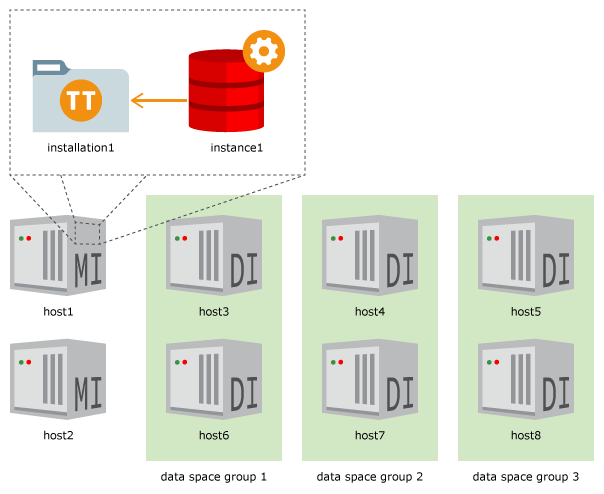Creating the Initial Management Instance
TimesTen Scaleout uses management instances to configure and manage a grid. A management instance stores and maintains the model, a comprehensive list of the objects that give shape to a grid.
Note:
-
TimesTen Scaleout stores multiple versions of the model that may describe a previous, present, or desired structure of a grid. See Model Versioning.
-
Most model objects have a user-defined name. TimesTen Scaleout uses those names to define relationships between model objects. In general, each type of model object has its own namespace. See Grid Objects and Object Naming in Oracle TimesTen In-Memory Database Reference.
-
See Central Configuration of the Grid for a complete list of the types of model objects and their descriptions.
To ensure high availability for the management of the grid, TimesTen Scaleout enables you to create a standby management instance in an active standby configuration. It is highly recommended that you configure a standby management instance, which would be available in the case of a failure of the active management instance. If you only have a single management instance and it fails, the databases remain operational, but most management operations are unavailable until the management instance is restored. The steps to set up a standby management instance are discussed later in this chapter.
The ttInstanceCreate utility creates new
instances. You create the initial management instance with the
ttInstanceCreate utility by including the
-grid option to enable the instance for
TimesTen Scaleout management. Once you create a grid from this
instance, all subsequent instances associated with the grid are
created through the ttGridAdmin utility. All
instances in the grid share the same OS username as instance
administrator.
Note:
The tasks described in this and the next several
topics use a scenario of a grid with a K-safety
(k) set to 3 and
that consists of eight hosts: two hosts with a TimesTen
installation and a management instance, and three data space
groups with two hosts each, each host with a TimesTen
installation and a data instance. Figure 4-1 shows a
graphical representation of this scenario.
On a host with a TimesTen 22.1 installation,
create a management instance in a location of your choice, for
example, the/grid directory.
Note:
See Prerequisites and Installation of TimesTen Scaleout for information on how to install TimesTen and its prerequisites for TimesTen Scaleout.
% /grid/tt22.1.1.27.0/bin/ttInstanceCreate -name instance1 -location /grid -grid
Creating instance in /grid/instance1 ...
INFO: Mapping files from the installation to /grid/instance1/install
NOTE: The TimesTen daemon startup/shutdown scripts have not been installed.
The startup script is located here :
'/grid/instance1/startup/tt_instance1'
Run the 'setuproot' script :
/grid/instance1/bin/setuproot -install
This will move the TimesTen startup script into its appropriate location.
The 22.1 Release Notes are located here :
'/grid/tt22.1.1.27.0/README.html'Note:
-
TimesTen Scaleout sets
instance1as the default instance name of new instances when you create them with thettGridAdminutility. Subsequent instances that you create on the same host require that you provide a different name for the instances. The example usesinstance1to stay in line with the default value. You may use the name of your choice. -
TimesTen Scaleout creates a subdirectory with the instance name in the specified location. TimesTen Scaleout creates all instance files in this subdirectory. For example, the instance files of the
instance1management instance are allocated in the/grid/instance1directory of the local system. -
TimesTen Scaleout sets the default values for the TCP/IP port numbers of the instance daemon and server (
6624and6625, respectively) if you do not specify a value for the port numbers. Use the-daemonPortor-csPortoptions of thettInstanceCreateutility to set different values for the port numbers.
Ensure that you set the environment variables for the
instance1 management instance with the
ttenv script (ttenv.csh or
ttenv.sh) appropriate for your shell. See
Environment Variables.
For a Bourne-type shell, such as sh,
bash, zsh, or
ksh:
$ . /grid/instance1/bin/ttenv.sh
For a csh or tcsh
shell:
% source /grid/instance1/bin/ttenv.csh
For more information on the ttInstanceCreate
utility, see ttInstanceCreate in Oracle TimesTen In-Memory Database
Reference.
